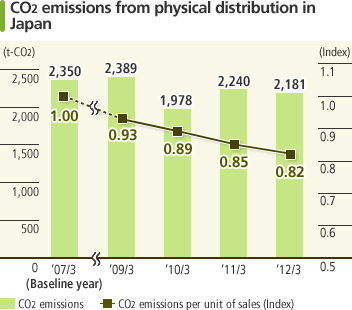Distribution-related Activities
The Nikon Group is engaged in a number of initiatives to reduce CO2 emissions in distribution based on the understanding that such efforts are urgently needed to mitigate global warming.
Reducing carbon emissions in distribution

Nikon Corporation is striving to reduce CO2 emissions in transportation by identifying its distribution routes including those of Group manufacturing companies in Japan, and obtaining numerical data on transportation volumes and CO2 emissions. In Japan, 2,181 tons of CO2 were emitted through distribution in the year ended March 31, 2012. Although our measures for the reduction of CO2 emissions had been expected to realize a reduction of 850 tons of CO2, a reduction of only 99 tons was achieved. The main reason for this was the planned modal shift from air transport to sea transport did not match the various business conditions, and so was implemented significantly less than expected.
Promoting eco-driving
Nikon Business Service Co., Ltd., which oversees transportation of goods for the Nikon Group, has installed digital tachographs and drive recorders on all of its large goods vehicles. These devices record varied information such as driving routes, departure and arrival times, maximum speeds on local roads and expressways, frequency of sudden starts, sudden acceleration and sudden braking, and rest times. By managing and evaluating this recorded information, we aim to further improve fuel efficiency and raise awareness of safety among our drivers. In addition, all of our drivers periodically attend eco-driving workshops.
Nikon Instech Co., Ltd. is promoting safe and eco-friendly driving by using telematics* to manage operation of its company vehicles, a move that is also helping its drivers to become more aware of the environment.
- *Telematics
A system in which mobile objects, such as automobiles, are equipped with a communications system that share information including fuel consumption.
"Stop Idling" Promotion

Externally powered vehicle
When transporting IC steppers and scanners and other devices by vehicle, it is necessary to strictly control the cargo room temperature by the use of in-vehicle heating, ventilating, and airconditioning (HVAC) equipment, for which engines used to be kept running even while the vehicle was parked. Now, however, there is no need for idling within the premises of our factories, where it has been made possible to power the equipment by the use of external sources. Nikon Business Service has equipped all of its vehicles for use with external power sources.
Introduction of eco-friendly vehicles and shortening of transport distances
The Nikon Group is gradually replacing its company vehicles and freight trucks with fuel-efficient models, and is promoting the introduction of eco-friendly vehicles. The Group will consider introducing freight trucks powered by natural gas.
From the perspective of transport efficiency, we will also proceed to shorten transport distances by reviewing the transport routes used in international distribution and to practice bulk transport.
Modal shifts
The Instruments Company is shifting from truck deliveries to railway transport, which causes lower environmental impact. The company is now gradually increasing the use of railways that can be easily implemented and then will promote further the modal shift transportation.
